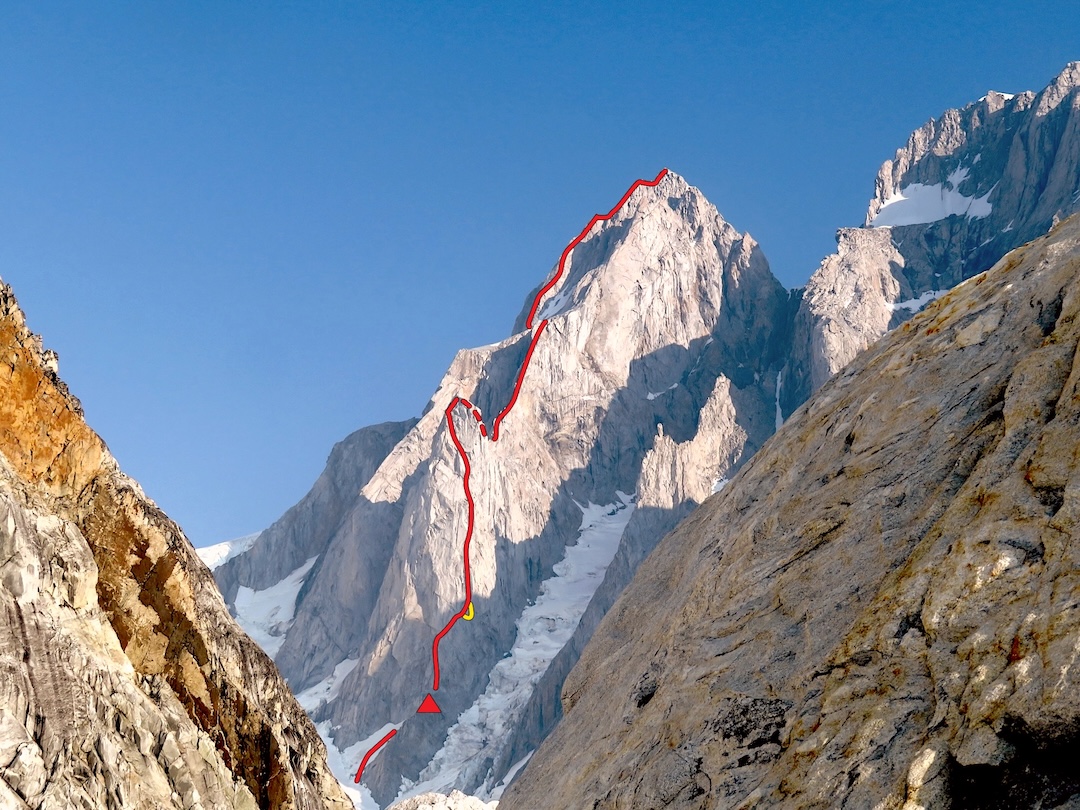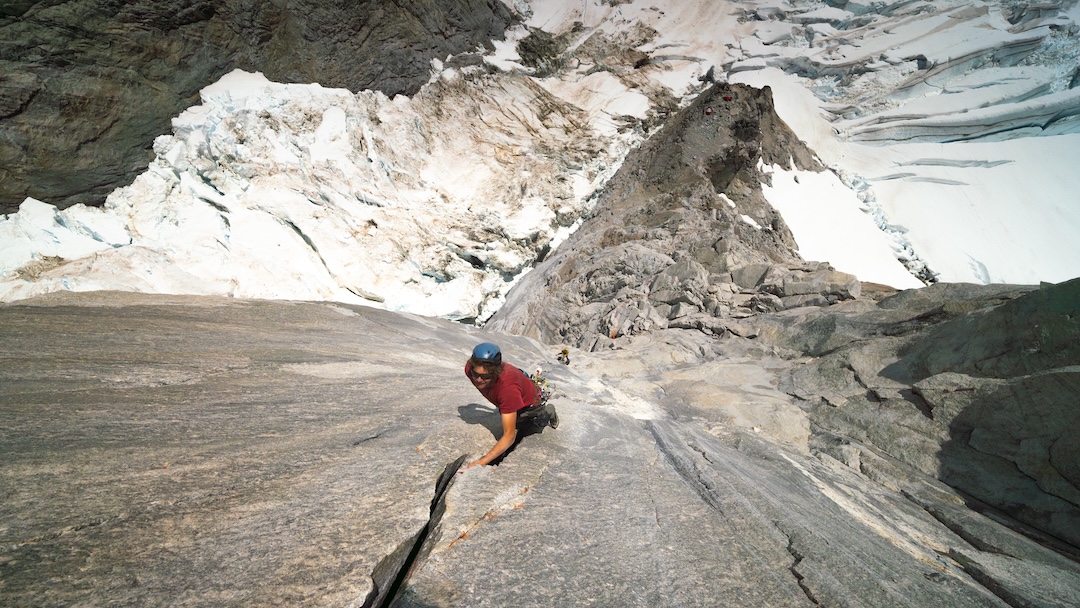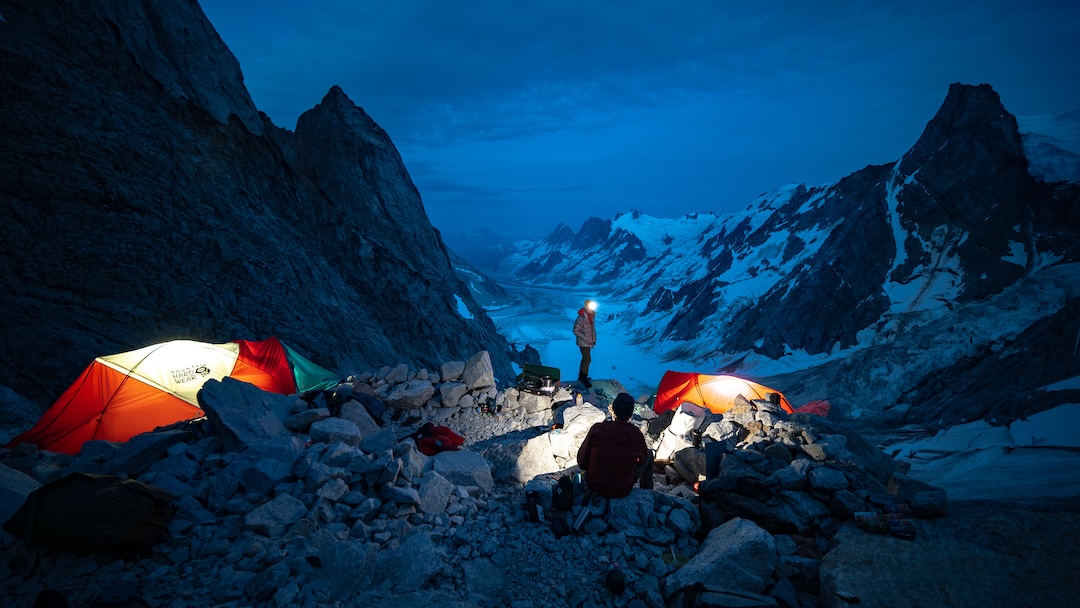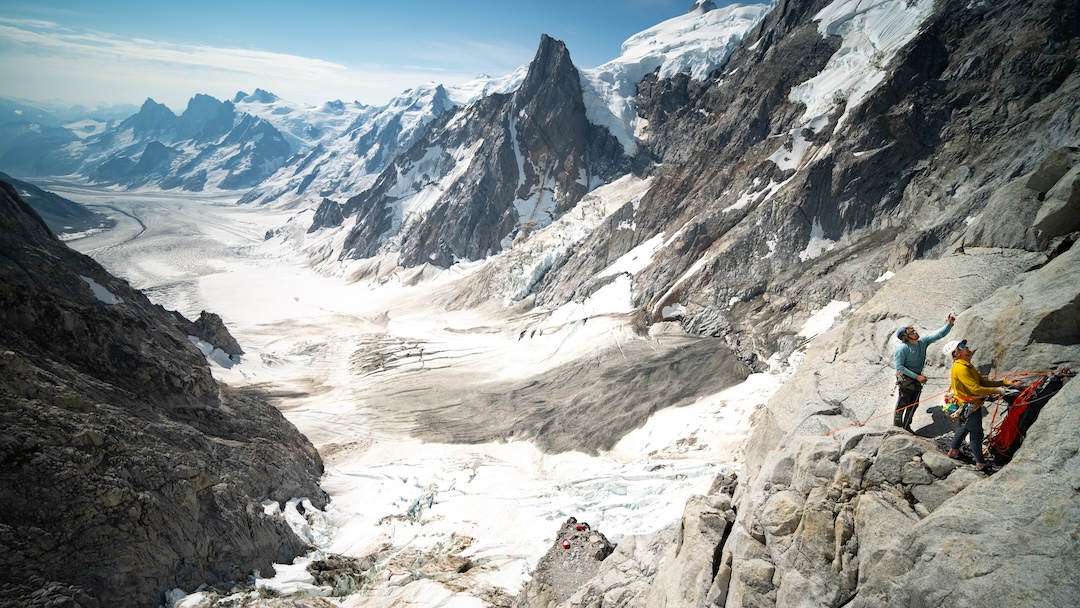Combatant Mountain, South Buttress, Free Ascent of the Incisor
Canada, British Columbia, Coast Mountains, Waddington Range
It was a dusty and hot afternoon on August 7 at the White Saddle Ranch on the Chilcotin Plateau. Big pine trees, a beautiful lake, and wide-open spaces dominated the landscape. Matt Maddaloni, Tim Emmett, and I sat on our enormous stack of gear, nervous and excited to get into the Coast Mountains, hidden in the distance.
Pilot Mike King, however, was in no rush to hurry us climbers in. “On call for fires,” he said, firmly. Mustachioed, somewhat gruff, but friendly, Mike is the de facto king birdman of the Waddington Range and has been since before I was born. Around these parts, his word is law.
And who could blame him? Assisting wildfire fighters from preventing large parts of the province from going up in flames was a hell of a lot more important than ferrying climbers into the Waddington Range.
So, we sat and waited atop the duffels and packs, swatting flies. Me, wishing I hadn’t sworn off my usual mountain pouch of Drum tobacco, Matt, sipping a beer, and Tim bouncing around in his usual fashion of a whirling dervish of psych.
As the afternoon wore on, just as we were losing hope for a ride, Mike walked over to the heli. “Let’s go,” he said. We jumped up like jackrabbits and threw our packs in.
A helicopter is a sort of magic portal—it felt as if we were transported immediately to the heavily crevassed landscape of the Tiedemann Glacier, with Mt. Waddington (4,019m) towering to the left and Combatant Mountain (3,762m) towering to the right.
We worked well into the night to get the essentials across the glacier and up a pitch of 5.10 to reach a large, protected platform at the start of our planned route on the south side of Combatant. Loud couloirs constantly dumped snow to our left and right. We dubbed it Madd Camp.
Sitting on a rock was a faded bottle of Jim Beam whiskey left by Matt, Paul Bride, and John Furneaux almost exactly 20 years prior. It seemed wrong not to take a swig of the ancient bottom-shelf booze that had sat through snowstorms, sunshine, and wind for two solid decades.

In an incredible 11.5-hour push in 2004 (after previous work on the lower pitches), without placing any bolts, Matt and John had established a route they named The Smoke Show (1,371m, ED2 5.12d A0). Their route started on the south side of the Incisor, a 2,000’ pillar, then continued up the Jawbone, a knife-edge that connects to the steeper upper south face of Combatant Mountain. Their ascent stood on the shoulders of Greg Child, Greg Collum, and Steve Mascioli’s route Belligerence, accomplished in an eight-day push in 1994; this was the first team to climb the Incisor, farther left and more on the west side than Smoke Show, and they also pioneered the Jawbone and upper south face. [Another route up the Incisor, also to the left of The Smoke Show, was climbed by Joshua Lavigne and Craig McGee in 2009 and called Defiance.]
We were here to free the feature in its entirety. Matt and John had come achingly close to accomplishing this when I had just finished high school. During their summit push, Matt took just one fall on the crux fourth pitch. Matt had returned with us this year, enthusiastic to revisit the place of one of his greatest adventures and gather some stills and drone footage of our efforts.
The next day, we ferried the rest of our gear up to Madd Camp and set to work on freeing the pitch that had eluded Matt all those years ago. After deeming it very difficult and snapping off a couple of critical crimps, I looked for other options. Swinging around, I found a series of holds to the right, then tagged up the power drill and we fired in a series of bolts. Sacrilegious in these mountains? Perhaps. But we had found an amazing 5.12+ pitch, which we called Smoke and Mirrors, that allowed the dots to connect.

The next pitch, called the Incision, was one of those pitches that belong in dreamscapes—an endless wide hand and fist crack (5.12) of the finest, fine-grained granite, culminating in a heart-pounding roof encounter, set in a place more akin to the Himalaya than British Columbia. It was followed by the Wobble Flake, which is basically unprotectable as it shifts as one climbs it. (Though disconcerting, it didn’t appear to me that it was at risk of disconnecting from the rock entirely.) Furneaux, in a lead for the ages, had linked these two pitches in 2004.
With the crux pitches more or less figured out, and Matt on drone duty, Tim and I set the alarm for a predawn start. Our strategy was “team free,” with only one of us freeing the cruxes. Not a perfect style but, as always there’s room for improvement.
After simul-climbing a handful of pitches, Tim handily dispatched the bolted pitch. I managed to repeat John’s link of the Incision and the Wobble Flake and hollered at the top of my lungs. We were now off to the races, following the line of least resistance. After a couple of variations to what Matt and John had done, we were atop the Incisor, staring down the Jawbone ridge.
This loose, stegosaurus-like crest of choss is a committing feature. Retreat from either side would almost surely result in disaster. Maddaloni, climbing like a bat out of hell, had pulled a block during their 2004 ascent and injured his arm. We took it slowly, dekeing from one side of the crest to the other in search of less unstable terrain. By nightfall we were feeling dangerously tired, and we opted to open-bivy without sleeping bags, almost at the end of the Jawbone.
With a stove on hand, we passed a hot water bottle back and forth through the hours. The night wore on as cold bivies always do. Sleep comes and goes, and it felt both brief and eternal at the same time. The sunrise came with a cloak of clouds over the peaks. Just beautiful.
Upon awakening, we started up a couple of wet, loose, groggy and coffee-less pitches which led us to the end of the Jawbone ridge, a huge ramp, and possible escape. But like the guys before us, we wanted summit Combatant, so we opted to join the south-facing route called Kshtatrya (Down-Cairn, 1982) to reach the top.
The rock went from awful to sublime. Golden knobs and dishes granted passage between the fissures. A handful of hours of simul climbing later and we gained the summit of Combatant. The vista was incredible, with views of the Coast Range in all directions. We could also make out Bute Inlet, and the ocean, which filled me with a sense of comfort, though we were a long way from home.
We rappelled back to the shelf and afterward to the Waddington-Combatant col. By now it was nightfall, and descending east back down the steep, crevasse-ridden col back to basecamp wasn’t an appetizing prospect in the dark. I balked at the potential plan and convinced Tim to march another hour back to a protected but snowy open-bivy in a bergschrund.
This time the night went from uncomfortable to verging on potentially dangerous. Sitting on our packs, we took turns rubbing each other’s feet. At one point, with my approach shoes soaked, I donned my TC Pros and stuffed them in my chalk bag. We shivered until a merciful hint of dawn had us staggering to our feet and working our way back down to the frightening col.
We negotiated the descent with Tim leading the way and making V-threads, rappelling into and climbing out of gigantic slots. Looming seracs were kissed by the morning sun, but luckily nothing toppled onto us. It was one of the most hazardous places I’d ever traveled through.
Arriving back at Madd Camp after a few more hours of descending, I felt numb and shattered from the climb. Matt was busily deconstructing our tents, planning for Mr. King’s pickup, and Tim and I had a brief nap. I awoke still exhausted and started moving packs and duffels down a 60-foot stretch of stone, back onto the glacier. Lowering a bag, dragging the line back up, lowering a line, dragging the line back up. Again and again.
Matt headed across the glacier to the pick-up spot, and I coiled and fixed a line for Tim. But in my deeply fatigued state I had only fixed a portion of the amount of rope needed to get to the glacier. There was no knot in the end. Tim jumped on his Grigri and headed down. “Oh fuck!” he shouted, when he realized he was about to rap off the end to a horrible, perhaps fatal, fall. Relying on his “BASE instinct,” as he called it, he noticed this at the very last second and halted his descent.
Wracked with guilt, I made my way down to the glacier and helped the boys ferry the remainder of the kit to the pick-up spot. Mike eventually arrived and we left the Tiedemann Glacier and those mighty peaks behind us.
Back home in Squamish, my big toe would remain numb for two months. The weight of the experience felt heavy after Tim’s near miss at the end of a long and at times risky climb. If I’ve learned anything, it’s this: When mentally tired, allow oneself time to rest and make sound decisions. We got lucky.
—Will Stanhope, Canada
Editor's Note: The climbers called their free variation on the Incisor and the Combatant link-up Smoke and Mirrors (1,371m, ED2 5.12+).




